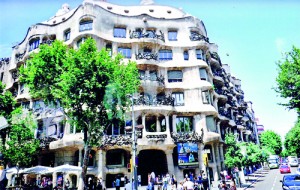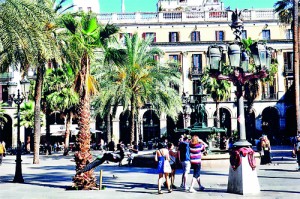Walking in Gaudi country
When Antonio Gaudi was young, one of his teachers described him as “either a genius or completely crazy”. His architectural marvels are now visited by millions of people from all over the world.
Gaudi was a deeply religious man who went to church every day. He was crossing the road to go to church when he was knocked down by a tram and as he was shabbily dressed the bystanders mistaking him for a beggar were reluctant to take him to a hospital thinking he could not afford it.

Casa Mila: Gaudi’s housing complex inspired by a sea wave
The tragic delay in hospitalisation resulted in Gaudi’s death aged 74 in a charity hospital, (now a public library).
The money he collected from his work all went towards his masterpiece the Sagrada Familia, a Roman Catholic Gothic style church in the process of construction. This now world heritage project was interrupted during the Spanish Civil War. Gaudi is buried in the crypt. Unfortunately, some of the drawings and models for the other facades – the Passion, Ascension were burnt during the Civil War and are now being recreated by other architects.
The entrance to the church is the Nativity scene. The donkey on which Mary is seated was bought from a gypsy woman and Gaudi took two weeks to choose a suitable animal according to his vision. There are twelve towers representing the Apostles, the first bishops of the church, crowned with symbols of mitres, the crozier, the cross, ring etc. With his fastidious desire for perfection, a man was made to hang so that the exact position of the body could be captured when Gaudi created a statue of Jesus on the cross for the church.
Gaudi found a benefactor in Eusebi Guell, son of an industrialist and an economist, lawyer and scholar of humanities. Their collaboration created masterpieces though Guell’s wife, dismissed his work as impractical and threw out the furniture that Gaudi designed
The Casa Mila La Pedrera apartment was designed for the industrialist Pere Mila with the architect’s innovations of a curved sea wave giving a rough outer appearance resembling an open quarry. The complex comprises two apartment blocks linked by inner courtyards. Seawaterscapes in pastel colours adorn the ceiling and entrance walls. The building is now a World Heritage Site and owned by a bank.
On the fourth floor the visitor can see the reproduced living quarters of that era and the decorative aspects of Gaudi from knobs to doors and flooring. The uppermost floor served as a laundry with arched ceilings like waves and the roof with its twisted chimneys. It was one of his innovative works and Gaudi experimented with trying to get a carriage or car to drive up to each apartment.
From a family of coppersmiths, Gaudi was born in June 1852 at Reus in Catalonia and came to Barcelona when he was 16. As a child he was sickly and could not go to school till much later, thus studying nature closely.
Gaudi was kind to his workers and began a school for the workers near the site of the Sagrada Familia and he himself moved nearer the church with his niece and her mentally disturbed child near the end of his life.
Colonia Guell on the outskirts of Barcelona was a textile village where Eusebi Guell had his factories. In order to provide good facilities for his workers, he obtained Gaudi’s assistance. A church was built but was not completed. The building is positioned for the light to stream into the main church, aspects of nature thus brought into play. Building commenced in 1908 but in 1914 the Guell family abandoned the project.
Palau Guell on a road leading off the La Ramblas is the home designed for the Guell family and its attention to detail is truly amazing. It is the only house that Gaudi completed and which remains unchanged. The basement was the stables and the roof terrace has twenty of his signature styled chimneys crafted with shards of glass, and rainbow coloured porcelain (from the road they looked like gigantic ice cream cones). The dining room with the adjacent placement for the organ; the room where private concerts were held with intricate

Gaudi’s lamps in the Plaza Reial
carving, inlay work, the billiard room and the bedrooms leave the visitor gazing in wonder at the architect’s creativity.
Park Guell on the outskirts of Barcelona is another World Heritage site. Count Guell once again collaborated with Gaudi to turn this neglected area with its salubrious and scenic surroundings near the sea into a future high end housing development between the years 1900 – 1914. The project never really took off completely but in the meantime Gaudi ensured that his creativity was stamped on the Park.
When his work on the Sagrada Familia commenced he used to walk from the park site where he lived to the church each morning at 6.30 a.m. The park has a bench shaped like a sea serpent in an arena where concerts could be held. Concrete balls along the pathways are a reminder to the fervent Catholic to continue with his rosary as this man did. Walk by the colonnaded archways, note drainage facilities for the rain water to drain and the underground shelter where market wares could be sold with a ceiling of his trademark mosaic work depicting sea creatures. Chance upon the gigantic colourful Salamander at the entrance which was our exit and one continues to marvel at this simple man who turned his dreams into reality.
A two hour walk to see more of the Modernista architecture of this period included the influence of another great rival architect, Lluis Domenechi Montaner. We walked into the pub where Gaudi met his friends and the hospital where he died and paused to see other buildings equally elaborate. Another site not to be missed in the city is the “Palau de la Musica Catalana theatre” with its gigantic sunburst chandelier and its spectacular stage with lots of unique features.
FC Barcelona
My curiosity was aroused by the recommendation on the web that “FC Barcelona”was worthy of a visit. The largest football stadium in Europe, it has a wealth of information laid out for the massive crowds who throng the complex. The trophies, cups, jerseys of star players, Lionel Messi’s golden boots, and a No. 10 jersey with “Obama” were on display. I-pads at a touch replayed those golden moments of key games. Large posters of contemporary players line the passage to the main entrance.
I saw the interview room, changing rooms, private chapel for prayer for the players before a match and walked through the players tunnel on to the pitch and an enormous but silent stadium. I had just missed the last match.
The club was formed when Hans Gamper along with friends from Switzerland, England and Spain founded a club in late 1899 to serve as a force for civil integration where everyone could speak their minds in Catalonia. The club over the years has been a force to be reckoned with.
Picasso Museum
A treat for the art lover is this collection of Picasso’s paintings, self-portraits of the artist as a youth and lastly one prior to his death. The styles vary from his early period, blue period and then his total reversal into cubism. There are pottery exhibits by his wife Jacqueline as well.
Picasso had strong links with the city and it was his express wish that a museum of his work be set up in this city.
Escriba
Featured in the guide books on Spain, the Escriba family has been well known for more than a century for their patisserie with its mosaic work and inviting display of cakes and other goodies on the Las Ramblas. Apart from their mouth watering pastries and cakes, I recommended their quiches as well.
Barcelona is indeed a city that never sleeps with the constant crowds exploring the Las Ramblas, once a dried-up river bed and now a two km avenue of restaurants, shops, flower booths, and musicians, lined with magnificent buildings, palm trees and Gaudi designed lamps.


